Board Game Gift Guide 2017!

It’s time again for our annual Board Game Gift Guide so you can find the perfect game gift!
This year’s Board Game Gift Guide includes 38 great game ideas!
You can scroll through the whole list or jump to the categories you’re interested in by clicking on a category title:
- Children’s Games
- Family Games
- Cooperative Games
- 2-Player Games
- Party Games
- Dice Games
- Deduction Games
- Gamer Games
- Superhero Games
Children’s Games
It’s not a secret – kids love playing games!
Here are 4 games children will both enjoy and learn from.
Match Madness
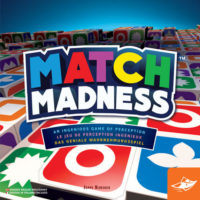 Ages: 7+, Players: 1-4, Time: 10-20 min
Ages: 7+, Players: 1-4, Time: 10-20 min
In Match Madness players race to solve patterns using their set of colorful, chunky blocks. There are two different ways to play Match Madness. Either way you play, each player gets their own set of the same blocks to play with. Each block contains 4 sets of paired symbols that are different on every block. The challenge of the game is to match up your blocks with the pattern displayed on the cards.
Because there are varying difficulty levels of the patterns, it’s a fun game the whole family can enjoy playing together.
See our full review of Match Madness.
Get a copy of Match Madness.
Slide Blast
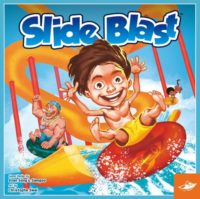 Ages: 6+, Players: 2-6, Time: 20 min
Ages: 6+, Players: 2-6, Time: 20 min
In Slide Blast, you get to build your own fun water slides!
Slide Blast is a tile-laying game where players add water slide tiles to extend their slide on every turn. The longer the slide, the more points you’ll earn. You can also earn bonus points by helping other players extend their slide as well. The rules are simple enough for players of all ages to understand. And the game theme is sure to appeal to players of all ages as well.
See our full review of Slide Blast.
Get a copy of Slide Blast.
Ticket to Ride: First Journey
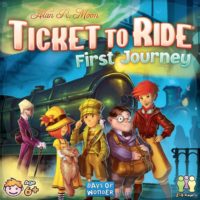 Ages: 6+, Players: 2-4, Time: 30 min
Ages: 6+, Players: 2-4, Time: 30 min
Ticket to Ride: First Journey takes the gameplay of the ever-popular Ticket to Ride series and scales it down for a younger audiences. Like the original, players collect train cards, claim routes on the map, and try to connect the cities shown on their tickets. But First Journey does so in a simplified fashion to make it very straight-forward for younger kids. The first player to complete 6 tickets wins.
Get a copy of Ticket to Ride: First Journey.
Dr. Eureka
 Ages: 8+, Players: 1-4, Time: 15 min
Ages: 8+, Players: 1-4, Time: 15 min
In Dr. Eureka, players are scientist working for the famed doctor. Players race to help him complete his experiments by placing the right elements together in their test tubes in the correct order. But the winner isn’t always the person moving the fastest because solving the patterns requires some thinking too. It’s a good thing the balls and test tubes are nice and durable because Dr. Eureka is a fast-paced game kids will love to play over and over.
Family Games
Really every game we review is one we consider a good “family game”. That being said, here are 5 games that perfectly fit the bill as great games for the whole family.
Kingdomino and Queendomino
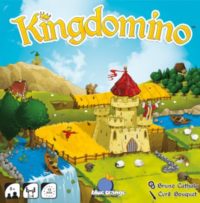 Ages: 8+, Players: 2-4, Time: 25 min
Ages: 8+, Players: 2-4, Time: 25 min
Both Kingdomino and Queendomino are tile-laying games where players construct their own kingdom made up of different terrain types and territories. The games have “domino” in the name because each tile has two portions. And when placing a tile, at least one of the sides needs to match a similar terrain already in the kingdom. Kingdomino was released first and is the simpler of the two games. Queendomino builds on the basics and adds a new terrain type, buildings, knights, a Queen, and a Dragon!
See our full review of Kingdomino and Queendomino.
Get a copy of Kingdomino and/or Queendomino.
Potion Explosion
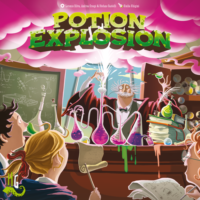 Ages: 8+, Players: 2-4, Time: 30-45 min
Ages: 8+, Players: 2-4, Time: 30-45 min
Potion Explosion is a marble-collection game with the coolest dispenser around. Players try to collect sets of colored marbles to match the potions they’re concocting. Once brewed, the potions can be used to gain special abilities during future turns. Also, the player takes the now used marbles and puts them back on top of the dispenser where they randomly fill in the columns of marbles. The game has a great ‘puzzle’ feel to it and a big ‘toy factor’.
See our full review of Potion Explosion.
Get a copy of Potion Explosion.
Legendary Inventors
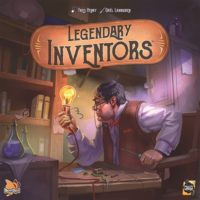 Ages: 10+, Players: 2-5, Time: 45 min
Ages: 10+, Players: 2-5, Time: 45 min
In Legendary Inventors, players use their team of historical world inventors to acquire patents and improve their skills as they race to be the best team of inventors ever known. Each turn, players choose one of their inventors to send to work – wherein they place wooden cubes on matching icons of inventions of their choice. When an invention is full, the rewards are divided between those who most contributed to its success. The game has a great balance of strategy and luck and can be enjoyed by young and old alike.
See our full review of Legendary Inventors.
Get a copy of Legendary Inventors.
Photosynthesis
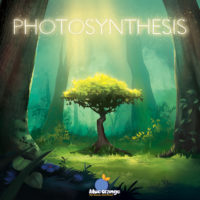 Ages: 10+, Players: 2-4, Time: 60 min
Ages: 10+, Players: 2-4, Time: 60 min
Photosynthesis is a recently-released board game that looks absolutely wonderful. The great news is that it’s a very engaging and fun game to play as well. Players have their own set of colored trees that they grow throughout the game. As the sun rotates around the board, different trees will receive light while others will be blocked in shadows. Players get light points as their trees receive light, which they’ll use to plant more seeds or grow their established trees even taller – both gaining more light points and blocking opponent’s trees. There’s plenty to think about as the forest builds over the seasons.
See our full review of Photosynthesis.
Get a copy of Photosynthesis.
Clank: A Deck Building Adventure
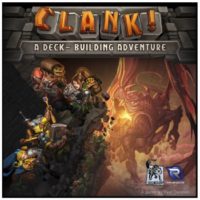 Ages: 12+, Players: 1-4, Time: 60 min
Ages: 12+, Players: 1-4, Time: 60 min
Since the success of Dominion, many deck-building games have been created. Well, Clank isn’t just like all the other deck-building game knock-offs. Clank is a deck-builder with a purpose! Sure players need to improve their deck of cards by purchasing highly-powered cards along the way. But players also must navigate into the dungeon depths of a board as they loot caves for treasure and race back to the top. As players move around the board, they make noise – “clanking noises” – which forces them to add their colored cubes to a bag. When the dragon is disturbed, a certain number of cubes are drawn – inflicting damage on those adventurers. It all makes for a lot of fun!
See our review of Clank: A Deck Building Adventure.
Get a copy of Clank: A Deck Building Adventure.
Cooperative Games
We’re big fans of cooperative board games. It’s a lot of fun playing a game where everyone works together rather than competes against each other. If you haven’t played a cooperative board game before, you’re missing out. Grad one of these games as a gift for a family member who will let you play along with them.
Mole Rats In Space
 Ages: 7+, Players: 2-4, Time: 20 min
Ages: 7+, Players: 2-4, Time: 20 min
Our first cooperative board game recommendation for this year’s gift guide is one the kids will enjoy. Mole Rats in Space is like a starter cooperative board game. Players are mole rats on a space station that’s being overrun by snakes. To win, players need to get 4 pieces of equipment to the escape pod in the center of the board. However, if a mole rat is bitten by a snake twice, if a mole rat falls through an air vent into outer space, if a snake gets into the escape pod, or if players run out of cards, they all lose. Cards show the actions players need to take on their turns, but players get to choose which direction those elements move around the space station. It takes a lot of good teamwork to win.
See our full review of Mole Rats In Space.
Get a copy of Mole Rats In Space.
Captain Sonar
 Ages: 14+, Players: 2-8, Time: 45-60 min
Ages: 14+, Players: 2-8, Time: 45-60 min
Captain Sonar is a semi-cooperative board game best played with a full group of 8 players. Players divide into two teams and each player is assigned specific duties on board their submarine (Captain, Chief Mate, Radio Operator, and Engineer). Each team tries to find and sink the other team’s sub before theirs gets sunk. It’s a real-time game full of frantic commands as players maneuver their submarines, drop bombs, ready torpedoes, and more. Both teams face each other, but there’s a shield between them so they can’t see what the other team is doing or where they’re going. Winning comes down to communication and teamwork in a true sense of both words.
Mansions of Madness 2nd Edition
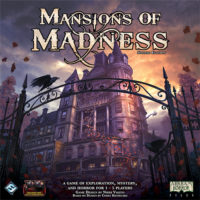 Ages: 14+, Players: 1-5, Time: 120-180 min
Ages: 14+, Players: 1-5, Time: 120-180 min
Mansions of Madness 2nd Edition is an amazingly engaging board game that seamlessly integrates the digital world with the physical. Players interact with the physical game components such as boards, cards, tokens, miniatures, and dice while the digital app unfolds the story before them. As players roll dice or use cards, they indicate the results in the app which then further unfolds the story accordingly. Each scenario is an immersive experience that keeps us wanting more. So I guess it’s a good thing there are already a number of game expansions as well.
See our full review of Mansions of Madness 2nd Edition.
Get a copy of Mansions of Madness 2nd Edition.
Robinson Crusoe: Adventures on the Cursed Island
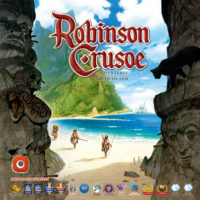 Ages: 14+, Players: 1-4, Time: 90-180 min
Ages: 14+, Players: 1-4, Time: 90-180 min
If you’re looking for a real challenge in cooperative board games, look no further than Robinson Crusoe 2nd Edition! As you might expect in Robinson Crusoe, players are stuck on a deserted island where they face daunting challenges. They’ll be faced with the challenges of building a shelter, finding food, fighting wild beasts, and protecting themselves from weather changes. Building walls around their homes, animal domestication, constructing weapons and tools from what they find and much more awaits them on the island. The game comes with 6 challenging scenarios that play out differently every time since the players choose how the game unfolds as they make tough decisions each turn. (FYI – it’s a tough game to win.)
Get a copy of Robinson Crusoe: Adventures on the Cursed Island.
2-Player Games
Cooperative games are great when you’ve got a group to work together with. But there are also times you want to go head-to-head in direct competition with a buddy. Here are a few 2-player games to consider for those times.
Santorini
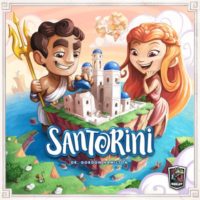 Ages: 8+, Players: 2, Time: 20 min
Ages: 8+, Players: 2, Time: 20 min
Simply put, Santorini is a fantastic game! Santorini is a 2-player board game where players compete to be the first player to get one of their Workers onto the 3rd floor of one of the buildings on the island. The first player to do so wins the game. The challenge comes in how well players can work their strategy of moving, building, and climbing while also blocking their opponent. Santorini is a very easy game to learn. Yet it also packs a strategic depth that players will discover along the way. Beware, it’s also a game you’ll want to play over and over and over…
See our full review of Santorini.
Get a copy of Santorini.
Onitama
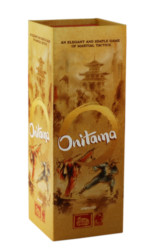 Ages: 8+, Players: 2, Time: 15 min
Ages: 8+, Players: 2, Time: 15 min
In Onitama, players try to either take out their opponent’s Master piece or move their own Master onto their opponent’s Temple Arch. It’s a simple and straightforward game that’s filled with strategic choices throughout. But it’s the unique way players maneuver their pieces that really makes this game shine! Each game of Onitama is played with 5 random movement cards (out of a 16-card deck). On their turn, a player must choose one of the movement pattern cards in front of them to use. They move one of their pieces in a like manner and then pass this movement card to their opponent. Thus, the movement cards used get recycled by both players over the course of the game. It’s very unique and delivers a solid, and challenging 2-player game experience.
See our full review of Onitama.
Get a copy of Onitama.
Patchwork
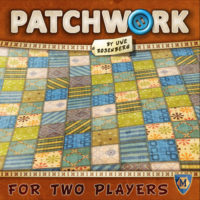 Ages: 8+, Players: 2, Time: 20 min
Ages: 8+, Players: 2, Time: 20 min
It may not sound like a gripping theme, but Patchwork is an addictive 2-player tile-placing board game. In Patchwork, players compete to build the most aesthetic (and high-scoring) patchwork quilt on a personal 9×9 game board. Appropriately enough, the currency in Patchwork is buttons. Players spend buttons to buy the Tetris-like tiles to add to their quilt. They also earn buttons as they move ahead on the time track. Each tile placed shows how many spaces the player moves their pawn ahead on the track. Since players can always look ahead to which tiles will be coming up in the market, there are multiple things to consider on each turn. So even though it’s a light game, there’s enough thinking required to make it an engaging, and addictive game.
Kulami
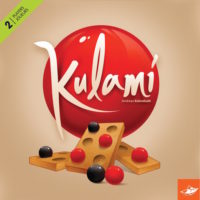 Ages: 10+, Players: 2, Time: 20 min
Ages: 10+, Players: 2, Time: 20 min
Kulami is an abstract, 2-player board game that’s also a 2013 Mensa Select winner. Kulami comes with 17 square and rectangular wooden tiles of different sizes. Players arrange the tiles in any manner they’d like to create the game board. The rules show one way to create and 8 x 8 square board, but players can make it as uniform or irregular as they like — adding to the variability in how the game will play out. Then players take turns placing their colored marbles following the placement rules. Where one player places a marble determines which row or column their opponent must place their marble. The back and forth play continues until all the marbles are placed or a player is unable to place a marble. Players then collect the wooden tiles where they have a majority. The player with the most total number spaces on their collected tiles wins.
See our full review of Kulami.
Get a copy of Kulami.
Party Games
Party games are great to play over the holidays. Whether with family or friends, people simply love to play party games. Here are a handful of party game suggestions to give as gifts.
Codenames: Pictures
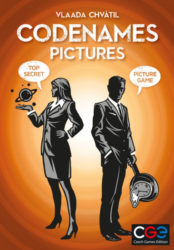 Ages: 10+, Players: 2-8, Time: 10-20 min
Ages: 10+, Players: 2-8, Time: 10-20 min
Two years ago we recommended Codenames for a great game gift. We’re back at it again this year but with Codenames: Pictures. Given a choice between the two games, we actually prefer Codenames: Pictures. Really though, both are fantastic group games. Players split into two teams and each team assigns one player to be the spymaster. It’s their job to get the rest of their team to correctly guess their secret agents before the other team identifies all theirs. The major restriction is that the spymasters can only single words as clues. It’s a fun game that we can never stop playing after just one game.
See our full review of Codenames: Pictures.
Get a copy of Codenames: Pictures.
Hive Mind
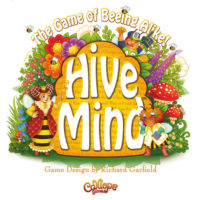 Ages: 8+, Players: 3-12, Time: 30 min
Ages: 8+, Players: 3-12, Time: 30 min
Hive Mind may look like a children’s game but it’s fun players of all ages. We even took it to a New Years Eve party last year and just played with adults. We all had a blast. Hive Mind is a game where players write down their answers to different questions and hope their answers match what other players write (think like the hive). Because the players who get the lowest score each round move down in the hive – on their way to getting kicked out! Once one (or more) players are booted from the hive the game ends. Everyone else wins!
See our full review of Hive Mind.
Get a copy of Hive Mind.
Imagine
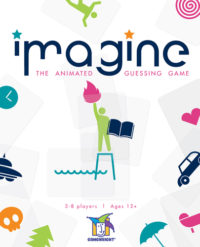 Ages: 12+, Players: 3-8, Time: 15-30 min
Ages: 12+, Players: 3-8, Time: 15-30 min
Imagine is a type of guessing game where players try to name what the active player is portraying. Only in this case, the active player uses transparent cards with all sorts of markings and symbols to convey their idea. On their turn, the active player draws a topic card and choose one of the 8 listed items to depict. The game comes with 61 cards which can be placed next to each other, superimposed, or even animated – whichever will help most. The only stipulation is that the active player can’t say anything. Both the active player and the person who guesses correctly gets 1 point. The game ends after each player gets to be the active player twice, after which the player with the most points wins.
Sushi Go Party!
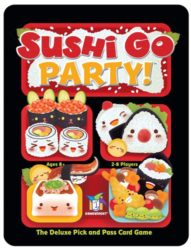 Ages: 8+, Players: 2-8, Time: 20 min
Ages: 8+, Players: 2-8, Time: 20 min
Sushi Go! released in 2013 and quickly became a very popular card-drafting game. Well, now there’s Sushi Go Party! where up to 8 players can join in the fun. Players start the game with a hand of cards, which they must pick one card from, and then pass the rest to the player on their left. Picked cards go face-up in front of the player and will score at the end of the round. Each type of sushi scores differently so players need to assess which their opponents will try for and which they want to claim themselves. Players still earn points by picking winning sushi combos, but now they can also customize each game by choosing à la carte from a menu of more than 20 dishes.
Get a copy of Sushi Go Party!.
Dice Games
We write a lot about board games. But where would even ‘board’ games be without dice? Dice are a fun component of board games themselves but they also take center stage in many games. Here are some fun dice games to give as gifts.
Dice Forge
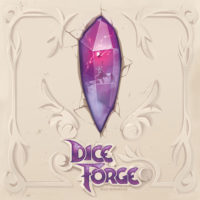 Ages: 10+, Players: 2-4, Time: 45 min
Ages: 10+, Players: 2-4, Time: 45 min
Dice Forge is a unique dice game where players get to change the face of their dice throughout the game! The awesome, customizable dice may sound like a novelty, but Dice Forge also packs in fun game play. Players roll their dice and collect the resources indicated on every turn – not just on their own turn. When it is their turn, they can spend those resources to upgrade their dice faces or purchase heroic feat cards that give points and special powers.
See our full review of Dice Forge.
Get a copy of Dice Forge.
Problem Picnic: Attack of the Ants
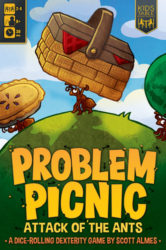 Ages: 6+, Players: 2-4, Time: 30 min
Ages: 6+, Players: 2-4, Time: 30 min
What would a picnic be without ants? Well, in Problem Picnic: Attack of the Ants players get to play the part of the ants! In the game, players are ant colonies trying to steal the best plates of food from a picnic. Not only do the results on the die faces determine the outcome, but where they land does too! That’s because there’s also a dexterity element to the game. The player that best organizes their collected food to meet the scoring objectives will be the best ant colony around! With plenty of dice rolling and good collecting, Problem Picnic includes a mix of luck and strategy that’s just right for family play.
See our full review of Problem Picnic: Attack of the Ants.
Get a copy of Problem Picnic: Attack of the Ants.
Sagrada
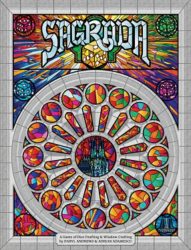 Ages: 8+, Players: 2, Time: 20 min
Ages: 8+, Players: 2, Time: 20 min
In Sagrada players draft dice and use the tools-of-the-trade to carefully construct their stained glass windows. At the start of every game, random pattern cards are revealed that show how players will score for that game. A handful of colored dice are rolled at the start of every turn and players, in turn, choose dice to add to their windows. Players have unique configuration cards that restrict where they can place certain dice in their window. That challenge is in following the placement rules while also trying to maximize your score. Win or lose, we love seeing our colorful, finished masterpieces at the end.
See our full review of Sagrada.
Get a copy of Sagrada.
Dicey Peaks
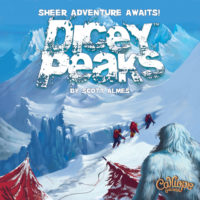 Ages: 8+, Players: 2-6, Time: 20-45 min
Ages: 8+, Players: 2-6, Time: 20-45 min
Even though Dicey Peaks has a tile-mountain board, we still consider it a ‘dice game’ because it’s all about pressing your luck with the dice rolls. In Dicey Peaks players race to the top of Yeti mountain. The board is made up of randomly placed levels of a mountain and players are racing to the summit. On their turn, players choose which dice to roll and then can choose to climb (move ahead) or rest (refill oxygen) but the amount will depend on their dice results. Players can also bust on their turn depending on a number of factors (like by rolling 3 Yeti symbols). It’s a fun, light dice rolling family game.
See our full review of Dicey Peaks.
Get a copy of Dicey Peaks.
Deduction Games
Do you know anyone who loves solving mysteries? These games that allow players to exercise their deductive prowess also make great game gifts.
EXIT: The Game
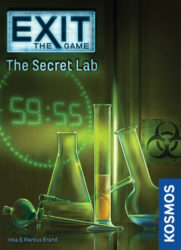 Ages: 12+, Players: 1-6, Time: 45-90 min
Ages: 12+, Players: 1-6, Time: 45-90 min
Escape rooms have popped up all around the world in the last few years. With the EXIT: The Game series, you can bring that escape-room fun to your own game table. In Exit: The Game, players work together to creatively solve puzzles, crack codes, collect objects and earn their escape. Just like with many escape-room facilities, there are many EXIT: The Game scenarios to choose from: The Secret Lab, The Abandoned Cabin, The Pharoah’s Tomb, The Polar Station, The Forbidden Castle, and The Forgotten Island.
See our full review of EXIT: The Game – The Secret Lab.
Get a copy of EXIT: The Game.
Concept
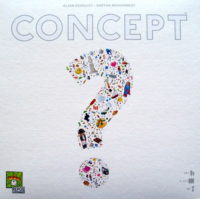 Ages: 10+, Players: 4-12, Time: 40 min
Ages: 10+, Players: 4-12, Time: 40 min
In Concept, players try to guess words through the association of icons on the board. Each round a team of two players choose a word or phrase from a deck of cards that the other players need to guess. Acting together, this team places pieces on the available icons on the game board. The first player to discover the word or phrase receives 2 victory points, the team receives points as well. Then play progresses with a new team of 2 players choosing a word and using the icons to give clues for the other players. It takes a little while to get warmed up to myriad of icons on the board, but once players do, it’s a tough game to stop playing. It’s a lot of fun.
Secrets
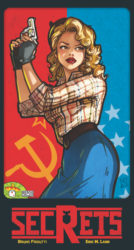 Ages: 10+, Players: 4-8, Time: 15-35 min
Ages: 10+, Players: 4-8, Time: 15-35 min
In Secrets players are randomly assigned a hidden team (the CIA or KGB) and are trying to collect the most points for their side. In addition, 1 or 2 players are secretly anti-establishment Hippies who are working for nobody. The Hippy player’s goal is to end the game with the fewest points. On their turn, a player offers one of two randomly drawn agent cards to another player. These cards are worth points and have varying good or bad abilities. That player either accepts the agent, in which case they score it, or they refuse, in which case the card returns to the active player and they score it. The game ends when a player has 5 cards, after which the teams are revealed and the team with the highest combined score wins, unless a Hippie has the single lowest score, in which case they win.
Stop Thief!
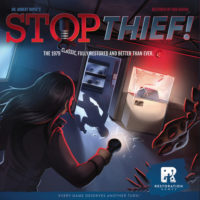 Ages: 10+, Players: 2-4, Time: 30-60 min
Ages: 10+, Players: 2-4, Time: 30-60 min
This revitalized game is a family game of logical deduction. It was first published in 1979 but has now been restored in modern glory. An invisible suspect commits a crime. Only the sounds they make give them away. With the help of an app, listen to the clues and figure out where they’re hiding. Play cards from your unique deck to move around the board, sneak through a window, or even get a private tip. Once you have the suspect pinned down, swoop in and make the arrest. But watch out because you’re not the only private eye on the hunt, and only one of you can slap the cuffs on the suspect and claim the reward.
Gamer Games
Who do you know that really, really loves board games? Check out these board games that require a bit more strategy or are dripping with a lot of theme.
Inis
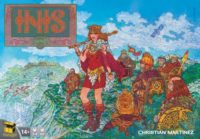 Ages: 14+, Players: 2-4, Time: 60-90 min
Ages: 14+, Players: 2-4, Time: 60-90 min
The first time I saw Inis was at a press event at Gen Con 2016. My first thought was that the game looked wonderful. But then I saw the box art and thought quite the opposite. Well, it’s a good thing I’ve learned to look past the box art because Inis is a fun board game of area control and card drafting. There are 3 different ways players can win: controlling 6 enemies, being in regions with 6 shrines, or being in 6 regions. As such, opponents are continually trying to keep things in check by stopping others from winning while still improving their own position. Players need to make tough judgement calls all game long over whether to participate in combat or whether to co-exist with a rival. It’s the type of game ‘gamers’ will love.
First Martians: Adventures on the Red Planet
 Ages: 10+, Players: 1-4, Time: 90 min
Ages: 10+, Players: 1-4, Time: 90 min
First Martians is a new game by Portal Games built on the same type of cooperative and challenging game play as Robinson Crusoe: Adventures on the Cursed Island. However, instead of a deserted island, players are fighting for survival on Mars. The immersion experience is further enhanced with an integrated app that maintains the balance and challenge throughout. Players have the option of taking on the game as a series of separate games or in a custom campaign mode in which each successive game builds on the last.
Get a copy of First Martians: Adventures on the Red Planet.
Twilight Imperium: Fourth Edition
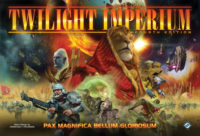 Ages: 14+, Players: 3-6, Time: 4-8 hours
Ages: 14+, Players: 3-6, Time: 4-8 hours
We’ve included Twilight Imperium before in our Board Game Gift Guide. But that was the 3rd edition. Well, now there’s a 4th edition and it’s getting super high marks in the global board game community. So even though we’ve never played it personally, we’re happy to suggest it for the serious gamer in your life. That’s because games can last all day! It’s a game of galactic conquest in which players take on the role of one of 17 factions vying for galactic domination through military might, political maneuvering, and economic bargaining. Every faction offers a completely different play experience.
Get a copy of Twilight Imperium: Fourth Edition.
The Colonists
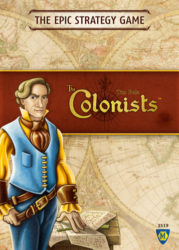 Ages: 12+, Players: 1-4, Time: 30-180 min
Ages: 12+, Players: 1-4, Time: 30-180 min
In The Colonists each player is a mayor of a village and must develop their environment to gain room for new farmers, craftsmen, and citizens. The main goal of the game is full employment, so players must create new jobs, educate the people, and build new houses to increase their population. But resources are limited, and their storage leads to problems that players must deal with, while also not forgetting to upgrade their buildings.
The Colonists is designed in different levels and scenarios, and even includes something akin to a tutorial, with the playing time varying between 30 minutes (for beginners) and 180 minutes (experts).
Superhero Games
Once again, this year superhero movies have been all the rage. It’s not surprising with the rise of so many good superhero movies over the last decade that superhero-themed board games would follow. Here are some fun games to consider for your superhero obsessed friends and family.
Love Letter: Batman
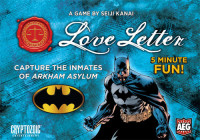 Ages: 10+, Players: 2-4, Time: 20 min
Ages: 10+, Players: 2-4, Time: 20 min
Love Letter: Batman is a simple card game based on the super popular Love Letter card game. There are only 16 cards in the whole game! The cards are numbered 1 through 8 with each number represented by a Batman hero or villain with special powers. For example, the #1 card is Batman and there are 5 of those cards. But the higher numbers #8 (Joker), #7 (Harley Quinn), #6 (Two-Face) only have one card of each. Players start with only one card in hand. On a turn, players draw one card and play one card, using the power on that card to expose others and (possibly) knock them out of the round. If you use Batman’s ability to KO someone, you score one point. If you’re the final player active in the round or the player with the highest card when the deck runs out, then you score a point. The first player to 7 points wins.
See our full review of Love Letter Batman.
Get a copy of Love Letter: Batman.
Marvel Dice Masters
Ages: 14+, Players: 2, Time: 60 min
Marvel Dice Masters is a coll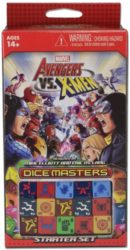 ectible dice-building game for 2 players. Each player fields one of the superhero teams, with each hero being represented by custom-tooled dice. Each team must be composed of up to 20 dice and a player can “purchase” dice only from his team. Each hero also has one or more character reference cards, which show the special abilities for the characters based on the die rolls.
ectible dice-building game for 2 players. Each player fields one of the superhero teams, with each hero being represented by custom-tooled dice. Each team must be composed of up to 20 dice and a player can “purchase” dice only from his team. Each hero also has one or more character reference cards, which show the special abilities for the characters based on the die rolls.
Since it’s based on the Marvel universe, it also may go without saying that there are a ton of expansions/dice packs: Captain America, Spider-Man, X-Men, Doctor Strange, Guardians of the Galaxy, and more.
Get a copy of Marvel Dice Masters.
Legendary: A Marvel Deck Building Game
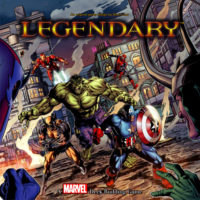 Ages: 14+, Players: 1-5, Time: 45 min
Ages: 14+, Players: 1-5, Time: 45 min
As the name suggests, this game is a deck-building game packed with Marvel heroes and villains. But it’s also a cooperative game! Players begin by choosing a mastermind villain (Magneto, Loki, Dr. Doom, etc.) to defeat. They stack that particular villain’s attack cards underneath it and modify the villain deck as needed based on that villain’s particular scheme. Players then choose a number of hero decks (Spider-Man, Hulk, Cyclops, Wolverine, etc.) and shuffle them together. Over the course of the game, players will recruit powerful hero cards to add to their deck to build a stronger and more resourceful deck to defeat the onslaught of villains.
Get a copy of Legendary: A Marvel Deck Building Game.
DC Comics Deck-building Game
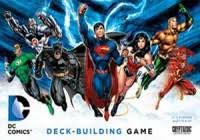 Ages: 15+, Players: 2-5, Time: 45 min
Ages: 15+, Players: 2-5, Time: 45 min
Not to be outdone, there’s also a deck-building game for DC Comic fans. To keep things simple, it’s appropriately called, DC Comics Deck-building Game. Each player chooses one of the seven over-sized hero card sets (Batman, Superman, Wonder Woman, Aquaman, The Flash, Green Lantern, Cyborg,), each of which has a special power. Each turn, a player starts with a hand of five cards and can acquire or conquer the five types of cards in the game: heroes, villains, equipment, super powers, and locations. Craft your hero deck into a well-oiled machine to take on the most vile villains in the DC Universe. (And of course, there are also plenty of expansions to get.)
Get a copy of DC Comics Deck-building Game.
If these games aren’t enough, you can always take a look at our Board Game Gift Guides from years past.
- 2016 Board Game Gift Guide
- 2015 Board Game Gift Guide
- 2014 Board Game Gift Guide
- 2013 Board Game Gift Guide
- 2012 Board Game Gift Guide
- 2011 Board Game Gift Guide

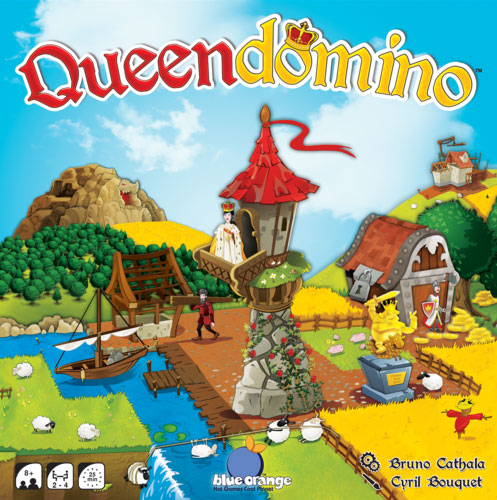
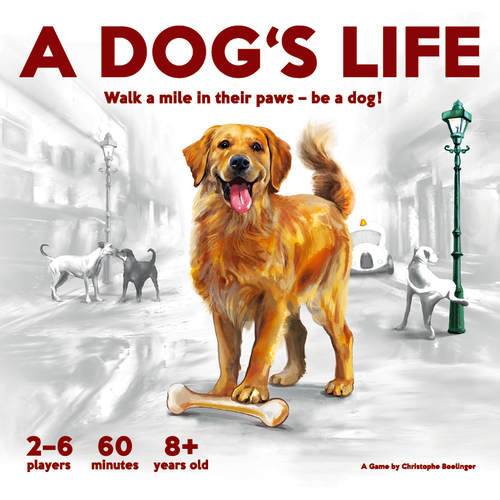

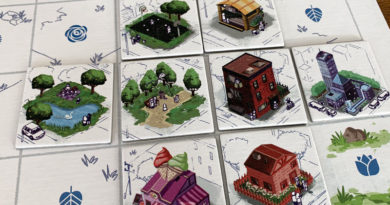

Great list as always! Many are already in my collection and many more are either on my wishlist or my “must play” list.
Thanks for helping distill the flood of games into a great batch of choices.
Okie – We’re glad to hear you appreciate us distilling the myriad of games down to some target lists to play. We even found ourselves being a lot more discriminating this past year on which games we get to our table.
This is my favorite post of yours for the year. Many games we have already and agree with your post. I’ve added a few to my wish list and I have purchased a few based upon your recommendation already. Thanks as always
Brad – Thanks for letting us know that both our reviews and gift lists help you find great games! If you’ve got suggestions of games for us to try out as well, let us know.
What are my plans for this Friday evening? Looking through your lists of games and researching the ones I don’t already own. It was a wishlist of yours a few years ago that got me back into gaming. Thanks.
Debbie – Sounds like a great plan! We love the expansive variety of games (themes, style, etc.). So many different ways to have fun.
Fantastic list! I’m now your newest follower. 🙂
Welcome aboard Cindy!